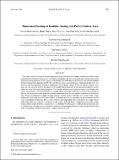| dc.contributor.author | Hartmann, Susan | |
| dc.contributor.author | Wex, Heike | |
| dc.contributor.author | Clauss, Tina | |
| dc.contributor.author | Augustin-Bauditz, Stefanie | |
| dc.contributor.author | Niedermeier, Dennis | |
| dc.contributor.author | Stratmann, Frank | |
| dc.contributor.author | Roesch, Michael | |
| dc.date.accessioned | 2016-12-05T21:38:54Z | |
| dc.date.available | 2016-12-05T21:38:54Z | |
| dc.date.issued | 2015-12 | |
| dc.date.submitted | 2015-09 | |
| dc.identifier.issn | 0022-4928 | |
| dc.identifier.issn | 1520-0469 | |
| dc.identifier.uri | http://hdl.handle.net/1721.1/105725 | |
| dc.description.abstract | This study presents an analysis showing that the freezing probability of kaolinite particles from Fluka scales exponentially with particle surface area for different atmospherically relevant particle sizes. Immersion freezing experiments were performed at the Leipzig Aerosol Cloud Interaction Simulator (LACIS). Size-selected kaolinite particles with mobility diameters of 300, 700, and 1000 nm were analyzed with one particle per droplet. First, it is demonstrated that immersion freezing is independent of the droplet volume. Using the mobility analyzer technique for size selection involves the presence of multiply charged particles in the quasi-monodisperse aerosol, which are larger than singly charged particles. The fractions of these were determined using cloud droplet activation measurements. The development of a multiple charge correction method has proven to be essential for deriving ice fractions and other quantities for measurements in which the here-applied method of size selection is used. When accounting for multiply charged particles (electric charge itself does not matter), both a time-independent and a time-dependent description of the freezing process can reproduce the measurements over the range of examined particle sizes. Hence, either a temperature-dependent surface site density or a single contact angle distribution was sufficient to parameterize the freezing behavior. From a comparison with earlier studies using kaolinite samples from the same provider, it is concluded that the neglect of multiply charged particles and, to a lesser extent, the effect of time can cause a significant overestimation of the ice nucleation site density of one order of magnitude, which translates into a temperature bias of 5–6 K. | en_US |
| dc.language.iso | en_US | |
| dc.publisher | American Meteorological Society | en_US |
| dc.relation.isversionof | http://dx.doi.org/10.1175/jas-d-15-0057.1 | en_US |
| dc.rights | Article is made available in accordance with the publisher's policy and may be subject to US copyright law. Please refer to the publisher's site for terms of use. | en_US |
| dc.source | American Meteorological Society | en_US |
| dc.title | Immersion Freezing of Kaolinite: Scaling with Particle Surface Area | en_US |
| dc.type | Article | en_US |
| dc.identifier.citation | Hartmann, Susan et al. “Immersion Freezing of Kaolinite: Scaling with Particle Surface Area.” Journal of the Atmospheric Sciences 73.1 (2016): 263–278. © 2016 American Meteorological Society | en_US |
| dc.contributor.department | Massachusetts Institute of Technology. Department of Earth, Atmospheric, and Planetary Sciences | en_US |
| dc.contributor.mitauthor | Roesch, Michael | |
| dc.relation.journal | Journal of the Atmospheric Sciences | en_US |
| dc.eprint.version | Final published version | en_US |
| dc.type.uri | http://purl.org/eprint/type/JournalArticle | en_US |
| eprint.status | http://purl.org/eprint/status/PeerReviewed | en_US |
| dspace.orderedauthors | Hartmann, Susan; Wex, Heike; Clauss, Tina; Augustin-Bauditz, Stefanie; Niedermeier, Dennis; Rösch, Michael; Stratmann, Frank | en_US |
| dspace.embargo.terms | N | en_US |
| dc.identifier.orcid | https://orcid.org/0000-0002-4064-5722 | |
| mit.license | PUBLISHER_POLICY | en_US |
